Legal System for Business Law: UK Classification, Source of Law, and Employment Law
VerifiedAdded on 2023/06/12
|8
|2669
|347
AI Summary
This report discusses the classification of laws in the UK, including statutory and common laws, and the role of the High Court and Supreme Court. It also explains case law as a source of laws and the process of making legislation. The report concludes with an overview of the Employment Rights Act of 1996 and the statutory duties of employers to their employees, as well as wrongful and unfair dismissal actions.
Contribute Materials
Your contribution can guide someone’s learning journey. Share your
documents today.
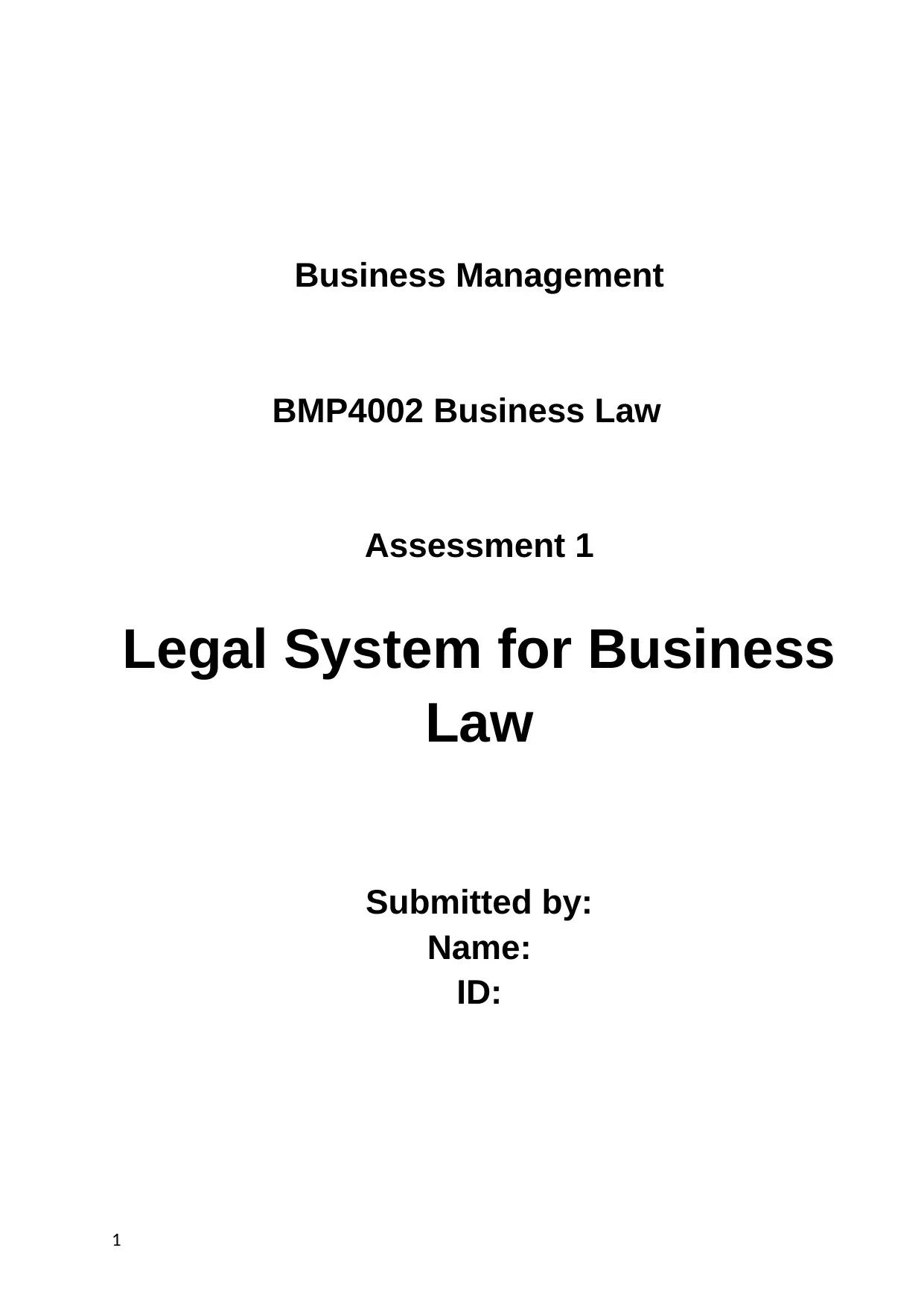
Business Management
BMP4002 Business Law
Assessment 1
Legal System for Business
Law
Submitted by:
Name:
ID:
1
BMP4002 Business Law
Assessment 1
Legal System for Business
Law
Submitted by:
Name:
ID:
1
Secure Best Marks with AI Grader
Need help grading? Try our AI Grader for instant feedback on your assignments.
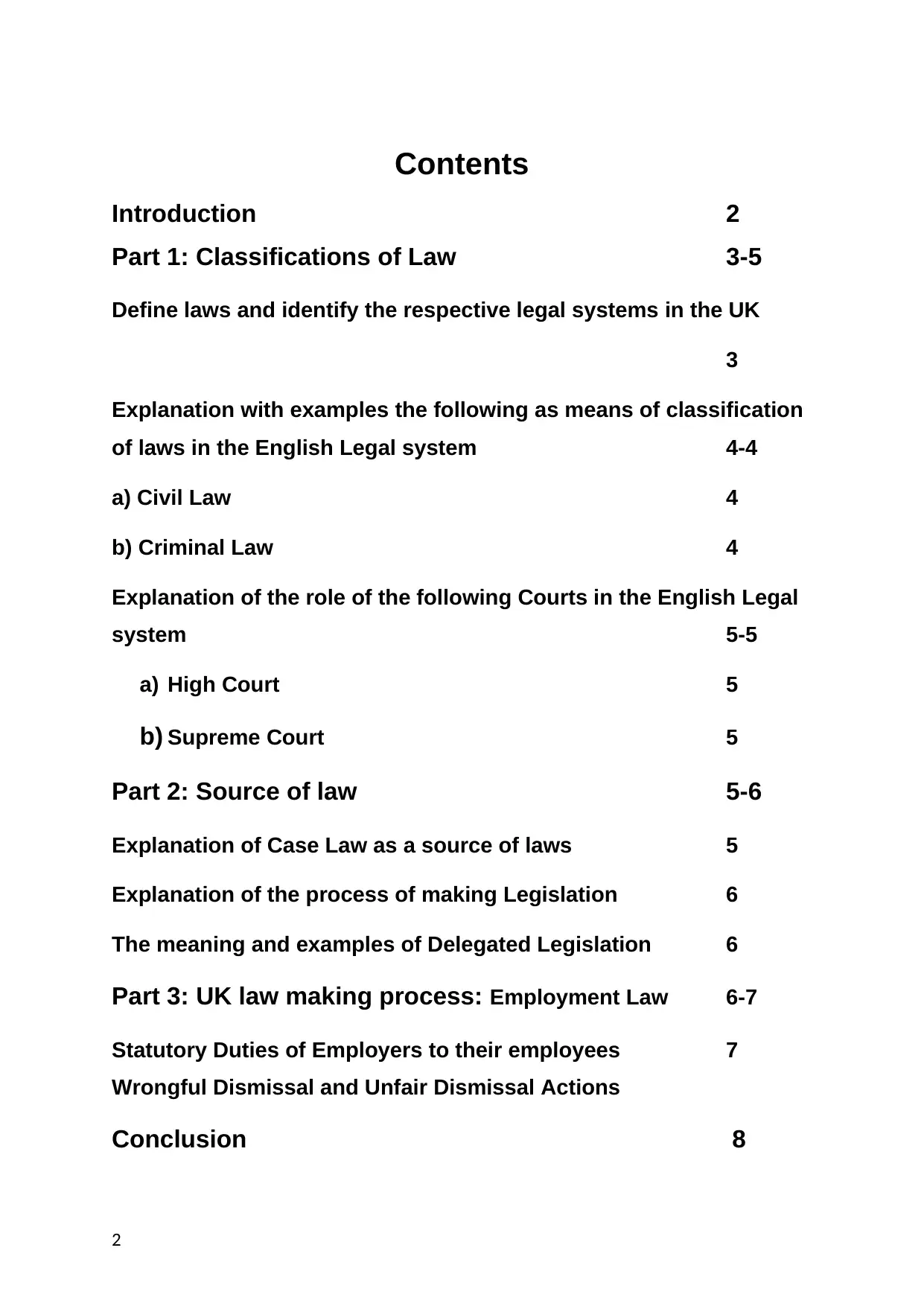
Contents
Introduction 2
Part 1: Classifications of Law 3-5
Define laws and identify the respective legal systems in the UK
3
Explanation with examples the following as means of classification
of laws in the English Legal system 4-4
a) Civil Law 4
b) Criminal Law 4
Explanation of the role of the following Courts in the English Legal
system 5-5
a) High Court 5
b) Supreme Court 5
Part 2: Source of law 5-6
Explanation of Case Law as a source of laws 5
Explanation of the process of making Legislation 6
The meaning and examples of Delegated Legislation 6
Part 3: UK law making process: Employment Law 6-7
Statutory Duties of Employers to their employees 7
Wrongful Dismissal and Unfair Dismissal Actions
Conclusion 8
2
Introduction 2
Part 1: Classifications of Law 3-5
Define laws and identify the respective legal systems in the UK
3
Explanation with examples the following as means of classification
of laws in the English Legal system 4-4
a) Civil Law 4
b) Criminal Law 4
Explanation of the role of the following Courts in the English Legal
system 5-5
a) High Court 5
b) Supreme Court 5
Part 2: Source of law 5-6
Explanation of Case Law as a source of laws 5
Explanation of the process of making Legislation 6
The meaning and examples of Delegated Legislation 6
Part 3: UK law making process: Employment Law 6-7
Statutory Duties of Employers to their employees 7
Wrongful Dismissal and Unfair Dismissal Actions
Conclusion 8
2
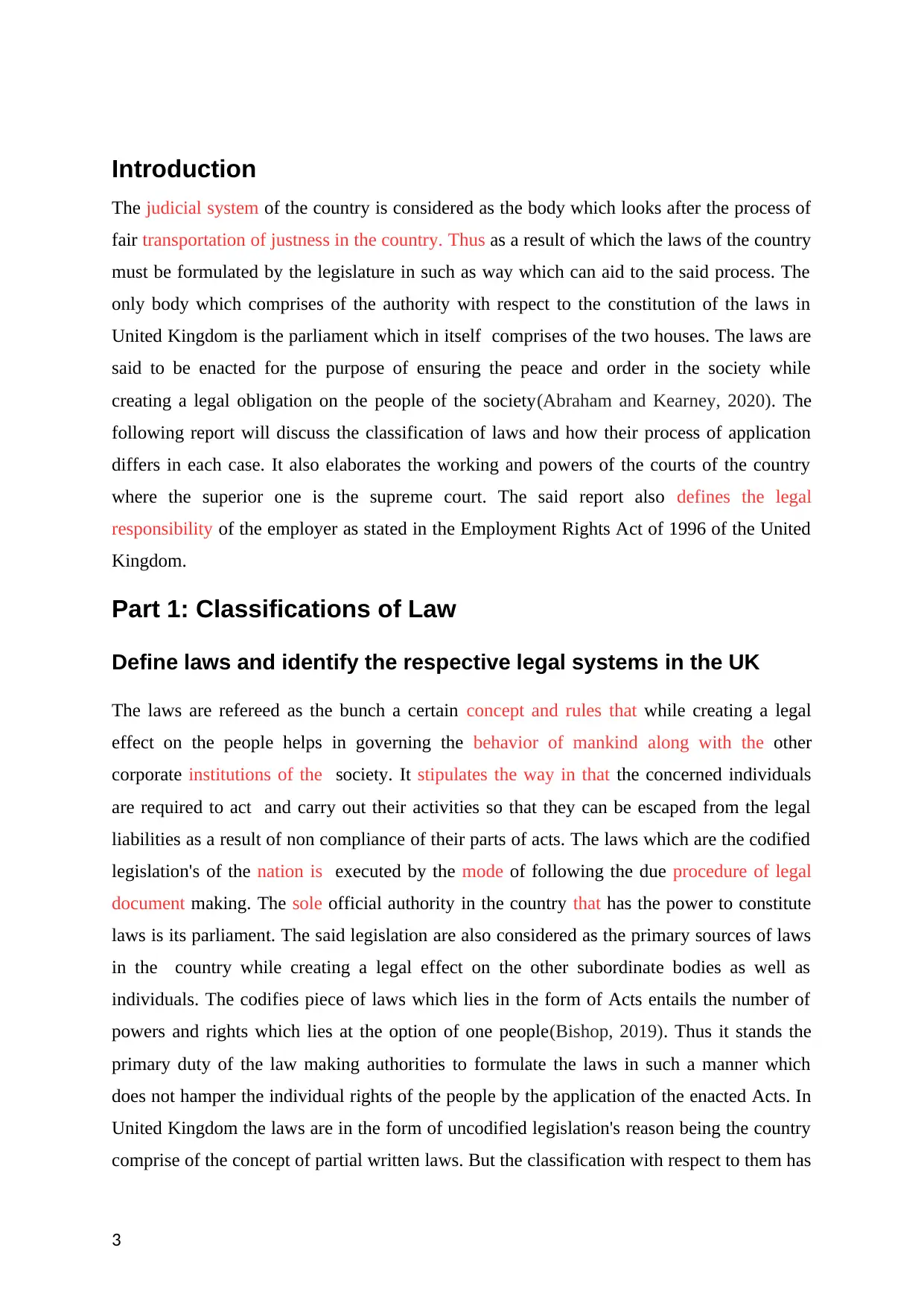
Introduction
The judicial system of the country is considered as the body which looks after the process of
fair transportation of justness in the country. Thus as a result of which the laws of the country
must be formulated by the legislature in such as way which can aid to the said process. The
only body which comprises of the authority with respect to the constitution of the laws in
United Kingdom is the parliament which in itself comprises of the two houses. The laws are
said to be enacted for the purpose of ensuring the peace and order in the society while
creating a legal obligation on the people of the society(Abraham and Kearney, 2020). The
following report will discuss the classification of laws and how their process of application
differs in each case. It also elaborates the working and powers of the courts of the country
where the superior one is the supreme court. The said report also defines the legal
responsibility of the employer as stated in the Employment Rights Act of 1996 of the United
Kingdom.
Part 1: Classifications of Law
Define laws and identify the respective legal systems in the UK
The laws are refereed as the bunch a certain concept and rules that while creating a legal
effect on the people helps in governing the behavior of mankind along with the other
corporate institutions of the society. It stipulates the way in that the concerned individuals
are required to act and carry out their activities so that they can be escaped from the legal
liabilities as a result of non compliance of their parts of acts. The laws which are the codified
legislation's of the nation is executed by the mode of following the due procedure of legal
document making. The sole official authority in the country that has the power to constitute
laws is its parliament. The said legislation are also considered as the primary sources of laws
in the country while creating a legal effect on the other subordinate bodies as well as
individuals. The codifies piece of laws which lies in the form of Acts entails the number of
powers and rights which lies at the option of one people(Bishop, 2019). Thus it stands the
primary duty of the law making authorities to formulate the laws in such a manner which
does not hamper the individual rights of the people by the application of the enacted Acts. In
United Kingdom the laws are in the form of uncodified legislation's reason being the country
comprise of the concept of partial written laws. But the classification with respect to them has
3
The judicial system of the country is considered as the body which looks after the process of
fair transportation of justness in the country. Thus as a result of which the laws of the country
must be formulated by the legislature in such as way which can aid to the said process. The
only body which comprises of the authority with respect to the constitution of the laws in
United Kingdom is the parliament which in itself comprises of the two houses. The laws are
said to be enacted for the purpose of ensuring the peace and order in the society while
creating a legal obligation on the people of the society(Abraham and Kearney, 2020). The
following report will discuss the classification of laws and how their process of application
differs in each case. It also elaborates the working and powers of the courts of the country
where the superior one is the supreme court. The said report also defines the legal
responsibility of the employer as stated in the Employment Rights Act of 1996 of the United
Kingdom.
Part 1: Classifications of Law
Define laws and identify the respective legal systems in the UK
The laws are refereed as the bunch a certain concept and rules that while creating a legal
effect on the people helps in governing the behavior of mankind along with the other
corporate institutions of the society. It stipulates the way in that the concerned individuals
are required to act and carry out their activities so that they can be escaped from the legal
liabilities as a result of non compliance of their parts of acts. The laws which are the codified
legislation's of the nation is executed by the mode of following the due procedure of legal
document making. The sole official authority in the country that has the power to constitute
laws is its parliament. The said legislation are also considered as the primary sources of laws
in the country while creating a legal effect on the other subordinate bodies as well as
individuals. The codifies piece of laws which lies in the form of Acts entails the number of
powers and rights which lies at the option of one people(Bishop, 2019). Thus it stands the
primary duty of the law making authorities to formulate the laws in such a manner which
does not hamper the individual rights of the people by the application of the enacted Acts. In
United Kingdom the laws are in the form of uncodified legislation's reason being the country
comprise of the concept of partial written laws. But the classification with respect to them has
3
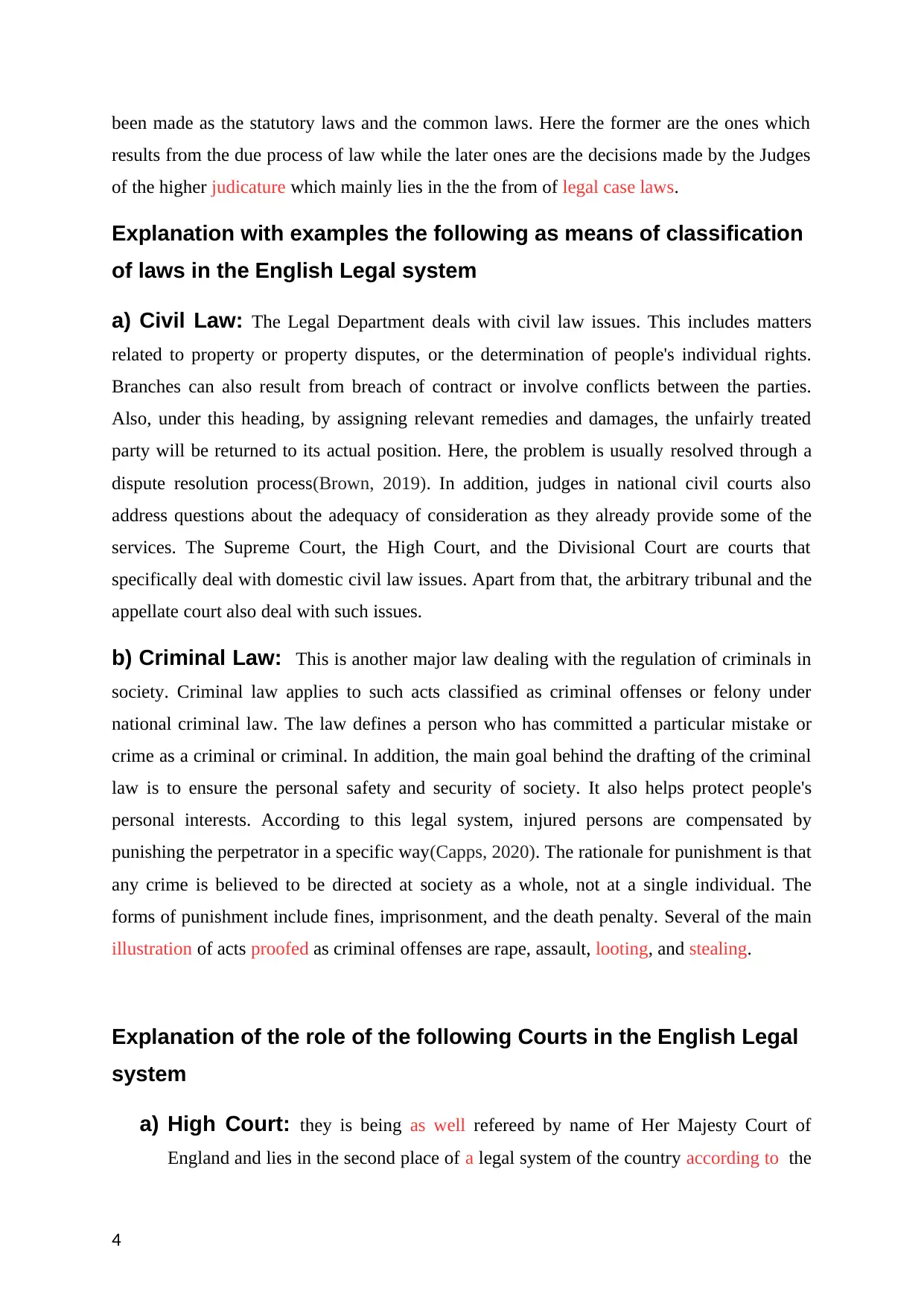
been made as the statutory laws and the common laws. Here the former are the ones which
results from the due process of law while the later ones are the decisions made by the Judges
of the higher judicature which mainly lies in the the from of legal case laws.
Explanation with examples the following as means of classification
of laws in the English Legal system
a) Civil Law: The Legal Department deals with civil law issues. This includes matters
related to property or property disputes, or the determination of people's individual rights.
Branches can also result from breach of contract or involve conflicts between the parties.
Also, under this heading, by assigning relevant remedies and damages, the unfairly treated
party will be returned to its actual position. Here, the problem is usually resolved through a
dispute resolution process(Brown, 2019). In addition, judges in national civil courts also
address questions about the adequacy of consideration as they already provide some of the
services. The Supreme Court, the High Court, and the Divisional Court are courts that
specifically deal with domestic civil law issues. Apart from that, the arbitrary tribunal and the
appellate court also deal with such issues.
b) Criminal Law: This is another major law dealing with the regulation of criminals in
society. Criminal law applies to such acts classified as criminal offenses or felony under
national criminal law. The law defines a person who has committed a particular mistake or
crime as a criminal or criminal. In addition, the main goal behind the drafting of the criminal
law is to ensure the personal safety and security of society. It also helps protect people's
personal interests. According to this legal system, injured persons are compensated by
punishing the perpetrator in a specific way(Capps, 2020). The rationale for punishment is that
any crime is believed to be directed at society as a whole, not at a single individual. The
forms of punishment include fines, imprisonment, and the death penalty. Several of the main
illustration of acts proofed as criminal offenses are rape, assault, looting, and stealing.
Explanation of the role of the following Courts in the English Legal
system
a) High Court: they is being as well refereed by name of Her Majesty Court of
England and lies in the second place of a legal system of the country according to the
4
results from the due process of law while the later ones are the decisions made by the Judges
of the higher judicature which mainly lies in the the from of legal case laws.
Explanation with examples the following as means of classification
of laws in the English Legal system
a) Civil Law: The Legal Department deals with civil law issues. This includes matters
related to property or property disputes, or the determination of people's individual rights.
Branches can also result from breach of contract or involve conflicts between the parties.
Also, under this heading, by assigning relevant remedies and damages, the unfairly treated
party will be returned to its actual position. Here, the problem is usually resolved through a
dispute resolution process(Brown, 2019). In addition, judges in national civil courts also
address questions about the adequacy of consideration as they already provide some of the
services. The Supreme Court, the High Court, and the Divisional Court are courts that
specifically deal with domestic civil law issues. Apart from that, the arbitrary tribunal and the
appellate court also deal with such issues.
b) Criminal Law: This is another major law dealing with the regulation of criminals in
society. Criminal law applies to such acts classified as criminal offenses or felony under
national criminal law. The law defines a person who has committed a particular mistake or
crime as a criminal or criminal. In addition, the main goal behind the drafting of the criminal
law is to ensure the personal safety and security of society. It also helps protect people's
personal interests. According to this legal system, injured persons are compensated by
punishing the perpetrator in a specific way(Capps, 2020). The rationale for punishment is that
any crime is believed to be directed at society as a whole, not at a single individual. The
forms of punishment include fines, imprisonment, and the death penalty. Several of the main
illustration of acts proofed as criminal offenses are rape, assault, looting, and stealing.
Explanation of the role of the following Courts in the English Legal
system
a) High Court: they is being as well refereed by name of Her Majesty Court of
England and lies in the second place of a legal system of the country according to the
4
Secure Best Marks with AI Grader
Need help grading? Try our AI Grader for instant feedback on your assignments.
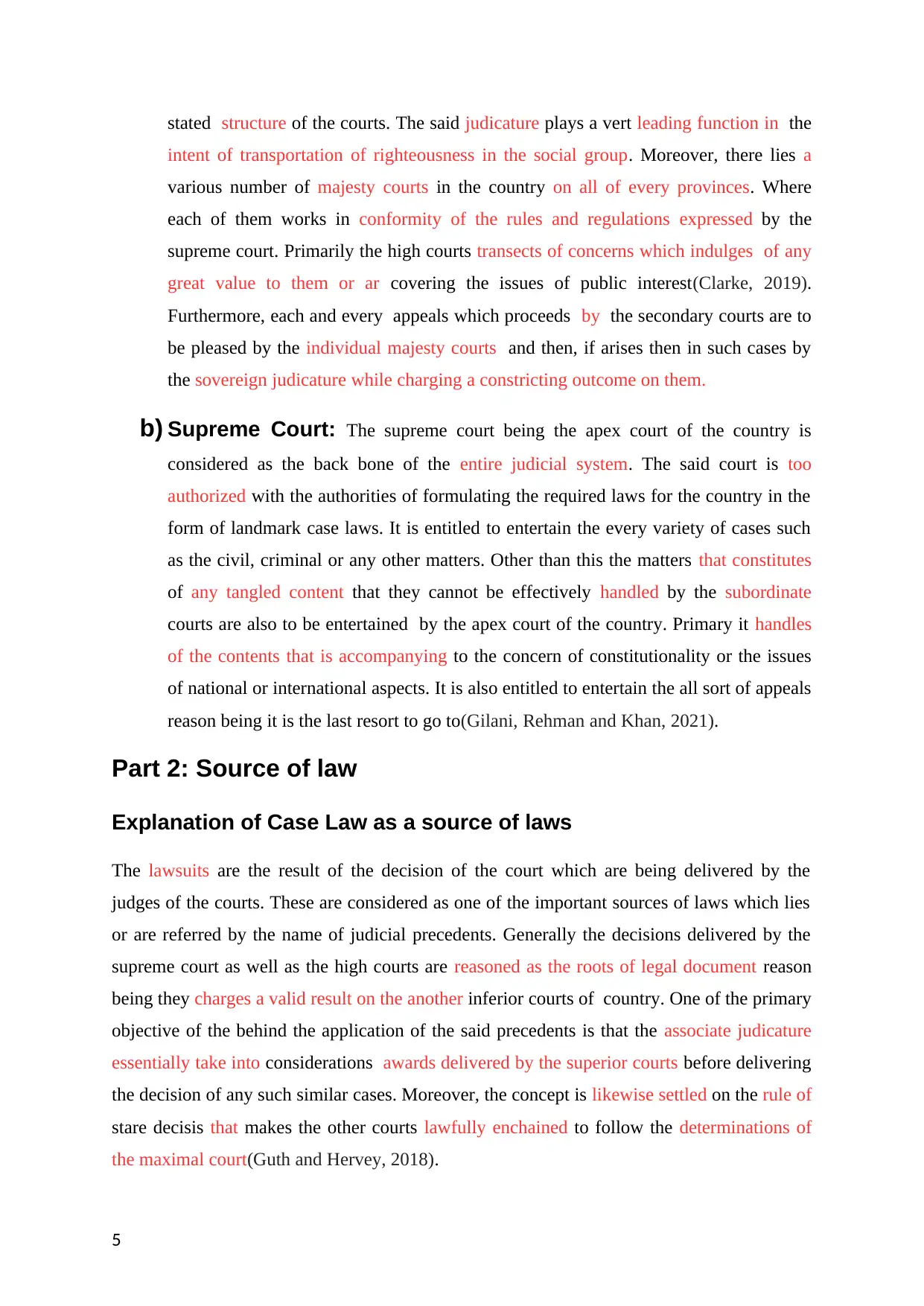
stated structure of the courts. The said judicature plays a vert leading function in the
intent of transportation of righteousness in the social group. Moreover, there lies a
various number of majesty courts in the country on all of every provinces. Where
each of them works in conformity of the rules and regulations expressed by the
supreme court. Primarily the high courts transects of concerns which indulges of any
great value to them or ar covering the issues of public interest(Clarke, 2019).
Furthermore, each and every appeals which proceeds by the secondary courts are to
be pleased by the individual majesty courts and then, if arises then in such cases by
the sovereign judicature while charging a constricting outcome on them.
b) Supreme Court: The supreme court being the apex court of the country is
considered as the back bone of the entire judicial system. The said court is too
authorized with the authorities of formulating the required laws for the country in the
form of landmark case laws. It is entitled to entertain the every variety of cases such
as the civil, criminal or any other matters. Other than this the matters that constitutes
of any tangled content that they cannot be effectively handled by the subordinate
courts are also to be entertained by the apex court of the country. Primary it handles
of the contents that is accompanying to the concern of constitutionality or the issues
of national or international aspects. It is also entitled to entertain the all sort of appeals
reason being it is the last resort to go to(Gilani, Rehman and Khan, 2021).
Part 2: Source of law
Explanation of Case Law as a source of laws
The lawsuits are the result of the decision of the court which are being delivered by the
judges of the courts. These are considered as one of the important sources of laws which lies
or are referred by the name of judicial precedents. Generally the decisions delivered by the
supreme court as well as the high courts are reasoned as the roots of legal document reason
being they charges a valid result on the another inferior courts of country. One of the primary
objective of the behind the application of the said precedents is that the associate judicature
essentially take into considerations awards delivered by the superior courts before delivering
the decision of any such similar cases. Moreover, the concept is likewise settled on the rule of
stare decisis that makes the other courts lawfully enchained to follow the determinations of
the maximal court(Guth and Hervey, 2018).
5
intent of transportation of righteousness in the social group. Moreover, there lies a
various number of majesty courts in the country on all of every provinces. Where
each of them works in conformity of the rules and regulations expressed by the
supreme court. Primarily the high courts transects of concerns which indulges of any
great value to them or ar covering the issues of public interest(Clarke, 2019).
Furthermore, each and every appeals which proceeds by the secondary courts are to
be pleased by the individual majesty courts and then, if arises then in such cases by
the sovereign judicature while charging a constricting outcome on them.
b) Supreme Court: The supreme court being the apex court of the country is
considered as the back bone of the entire judicial system. The said court is too
authorized with the authorities of formulating the required laws for the country in the
form of landmark case laws. It is entitled to entertain the every variety of cases such
as the civil, criminal or any other matters. Other than this the matters that constitutes
of any tangled content that they cannot be effectively handled by the subordinate
courts are also to be entertained by the apex court of the country. Primary it handles
of the contents that is accompanying to the concern of constitutionality or the issues
of national or international aspects. It is also entitled to entertain the all sort of appeals
reason being it is the last resort to go to(Gilani, Rehman and Khan, 2021).
Part 2: Source of law
Explanation of Case Law as a source of laws
The lawsuits are the result of the decision of the court which are being delivered by the
judges of the courts. These are considered as one of the important sources of laws which lies
or are referred by the name of judicial precedents. Generally the decisions delivered by the
supreme court as well as the high courts are reasoned as the roots of legal document reason
being they charges a valid result on the another inferior courts of country. One of the primary
objective of the behind the application of the said precedents is that the associate judicature
essentially take into considerations awards delivered by the superior courts before delivering
the decision of any such similar cases. Moreover, the concept is likewise settled on the rule of
stare decisis that makes the other courts lawfully enchained to follow the determinations of
the maximal court(Guth and Hervey, 2018).
5
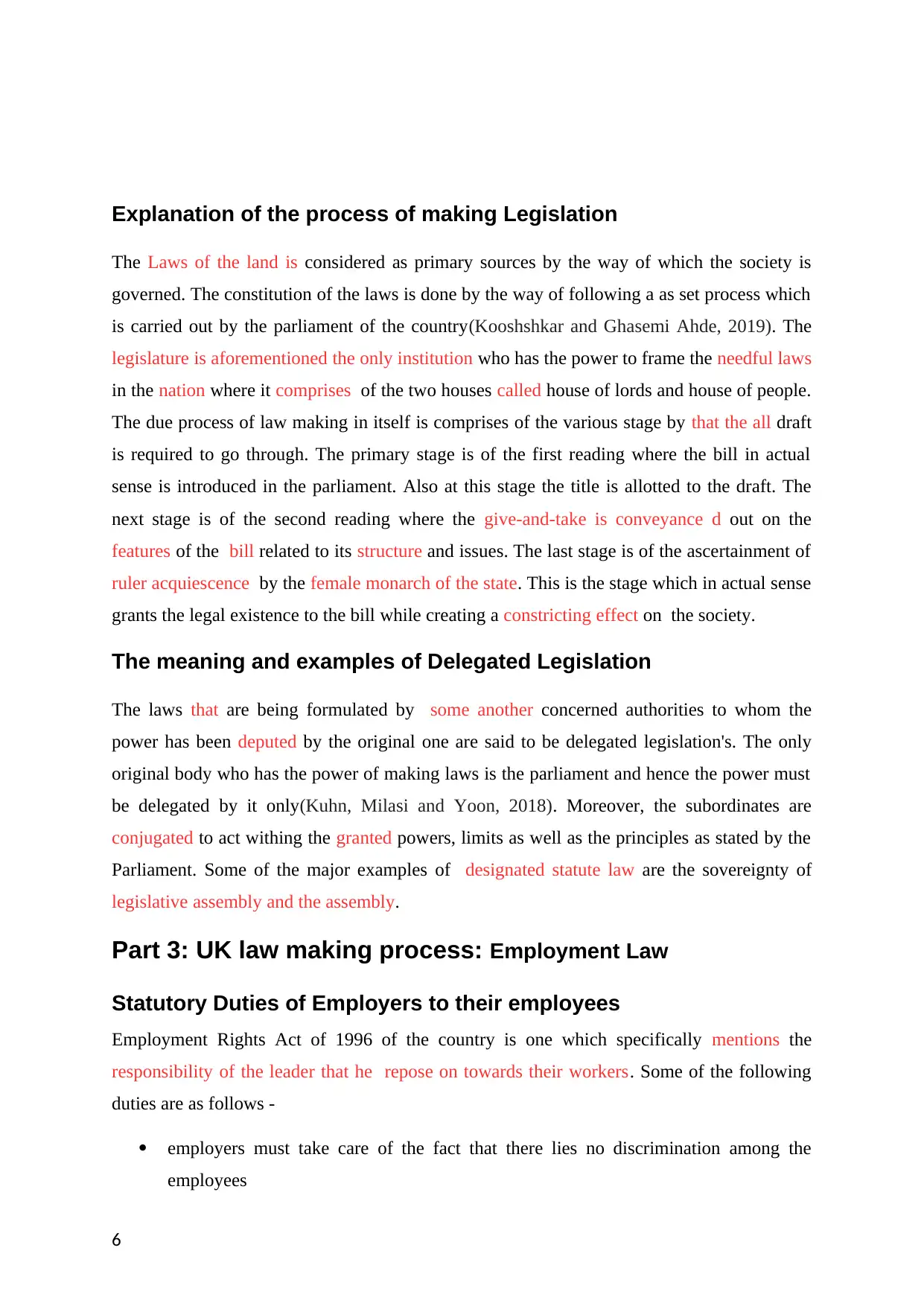
Explanation of the process of making Legislation
The Laws of the land is considered as primary sources by the way of which the society is
governed. The constitution of the laws is done by the way of following a as set process which
is carried out by the parliament of the country(Kooshshkar and Ghasemi Ahde, 2019). The
legislature is aforementioned the only institution who has the power to frame the needful laws
in the nation where it comprises of the two houses called house of lords and house of people.
The due process of law making in itself is comprises of the various stage by that the all draft
is required to go through. The primary stage is of the first reading where the bill in actual
sense is introduced in the parliament. Also at this stage the title is allotted to the draft. The
next stage is of the second reading where the give-and-take is conveyance d out on the
features of the bill related to its structure and issues. The last stage is of the ascertainment of
ruler acquiescence by the female monarch of the state. This is the stage which in actual sense
grants the legal existence to the bill while creating a constricting effect on the society.
The meaning and examples of Delegated Legislation
The laws that are being formulated by some another concerned authorities to whom the
power has been deputed by the original one are said to be delegated legislation's. The only
original body who has the power of making laws is the parliament and hence the power must
be delegated by it only(Kuhn, Milasi and Yoon, 2018). Moreover, the subordinates are
conjugated to act withing the granted powers, limits as well as the principles as stated by the
Parliament. Some of the major examples of designated statute law are the sovereignty of
legislative assembly and the assembly.
Part 3: UK law making process: Employment Law
Statutory Duties of Employers to their employees
Employment Rights Act of 1996 of the country is one which specifically mentions the
responsibility of the leader that he repose on towards their workers. Some of the following
duties are as follows -
employers must take care of the fact that there lies no discrimination among the
employees
6
The Laws of the land is considered as primary sources by the way of which the society is
governed. The constitution of the laws is done by the way of following a as set process which
is carried out by the parliament of the country(Kooshshkar and Ghasemi Ahde, 2019). The
legislature is aforementioned the only institution who has the power to frame the needful laws
in the nation where it comprises of the two houses called house of lords and house of people.
The due process of law making in itself is comprises of the various stage by that the all draft
is required to go through. The primary stage is of the first reading where the bill in actual
sense is introduced in the parliament. Also at this stage the title is allotted to the draft. The
next stage is of the second reading where the give-and-take is conveyance d out on the
features of the bill related to its structure and issues. The last stage is of the ascertainment of
ruler acquiescence by the female monarch of the state. This is the stage which in actual sense
grants the legal existence to the bill while creating a constricting effect on the society.
The meaning and examples of Delegated Legislation
The laws that are being formulated by some another concerned authorities to whom the
power has been deputed by the original one are said to be delegated legislation's. The only
original body who has the power of making laws is the parliament and hence the power must
be delegated by it only(Kuhn, Milasi and Yoon, 2018). Moreover, the subordinates are
conjugated to act withing the granted powers, limits as well as the principles as stated by the
Parliament. Some of the major examples of designated statute law are the sovereignty of
legislative assembly and the assembly.
Part 3: UK law making process: Employment Law
Statutory Duties of Employers to their employees
Employment Rights Act of 1996 of the country is one which specifically mentions the
responsibility of the leader that he repose on towards their workers. Some of the following
duties are as follows -
employers must take care of the fact that there lies no discrimination among the
employees
6
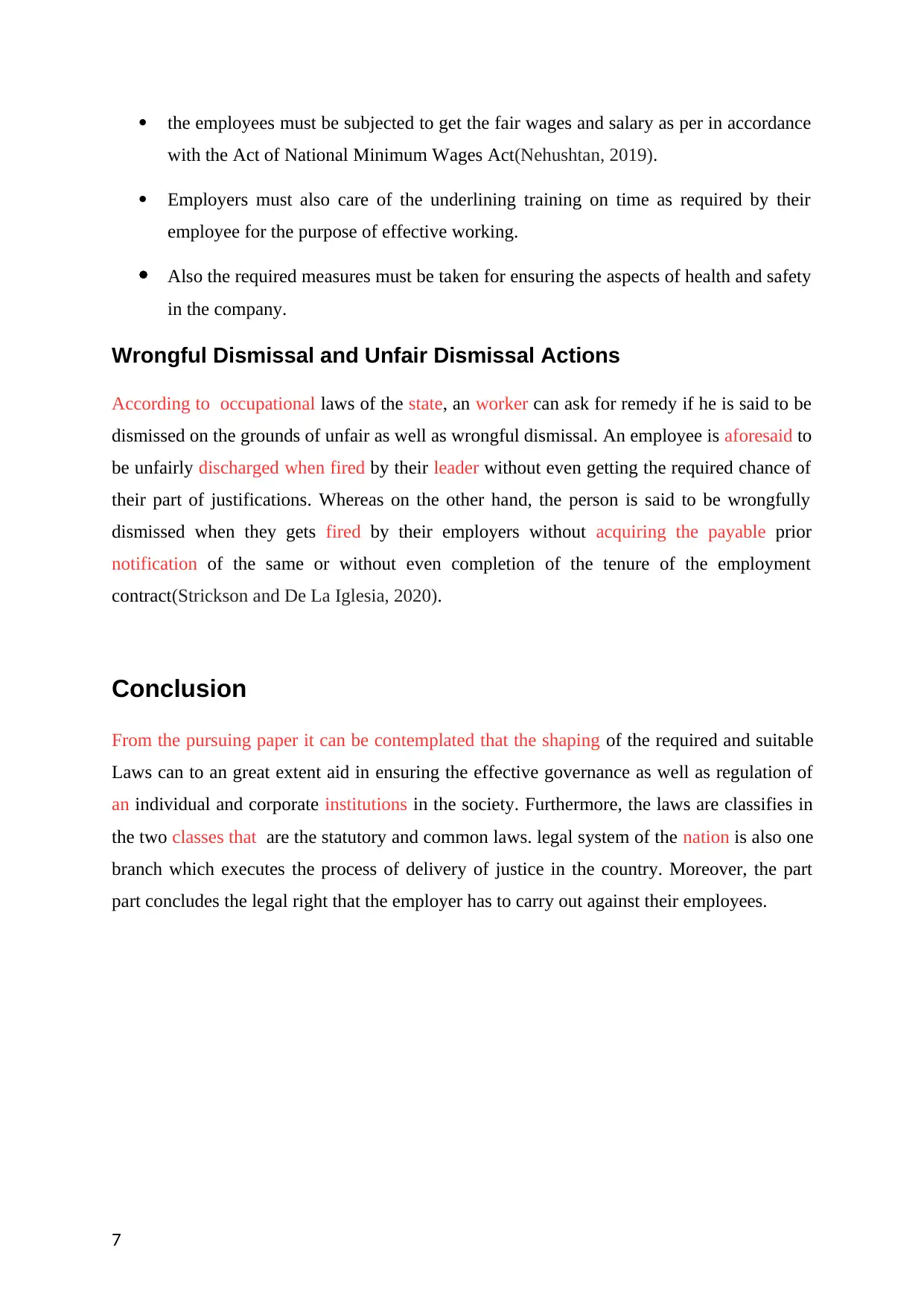
the employees must be subjected to get the fair wages and salary as per in accordance
with the Act of National Minimum Wages Act(Nehushtan, 2019).
Employers must also care of the underlining training on time as required by their
employee for the purpose of effective working.
Also the required measures must be taken for ensuring the aspects of health and safety
in the company.
Wrongful Dismissal and Unfair Dismissal Actions
According to occupational laws of the state, an worker can ask for remedy if he is said to be
dismissed on the grounds of unfair as well as wrongful dismissal. An employee is aforesaid to
be unfairly discharged when fired by their leader without even getting the required chance of
their part of justifications. Whereas on the other hand, the person is said to be wrongfully
dismissed when they gets fired by their employers without acquiring the payable prior
notification of the same or without even completion of the tenure of the employment
contract(Strickson and De La Iglesia, 2020).
Conclusion
From the pursuing paper it can be contemplated that the shaping of the required and suitable
Laws can to an great extent aid in ensuring the effective governance as well as regulation of
an individual and corporate institutions in the society. Furthermore, the laws are classifies in
the two classes that are the statutory and common laws. legal system of the nation is also one
branch which executes the process of delivery of justice in the country. Moreover, the part
part concludes the legal right that the employer has to carry out against their employees.
7
with the Act of National Minimum Wages Act(Nehushtan, 2019).
Employers must also care of the underlining training on time as required by their
employee for the purpose of effective working.
Also the required measures must be taken for ensuring the aspects of health and safety
in the company.
Wrongful Dismissal and Unfair Dismissal Actions
According to occupational laws of the state, an worker can ask for remedy if he is said to be
dismissed on the grounds of unfair as well as wrongful dismissal. An employee is aforesaid to
be unfairly discharged when fired by their leader without even getting the required chance of
their part of justifications. Whereas on the other hand, the person is said to be wrongfully
dismissed when they gets fired by their employers without acquiring the payable prior
notification of the same or without even completion of the tenure of the employment
contract(Strickson and De La Iglesia, 2020).
Conclusion
From the pursuing paper it can be contemplated that the shaping of the required and suitable
Laws can to an great extent aid in ensuring the effective governance as well as regulation of
an individual and corporate institutions in the society. Furthermore, the laws are classifies in
the two classes that are the statutory and common laws. legal system of the nation is also one
branch which executes the process of delivery of justice in the country. Moreover, the part
part concludes the legal right that the employer has to carry out against their employees.
7
Paraphrase This Document
Need a fresh take? Get an instant paraphrase of this document with our AI Paraphraser
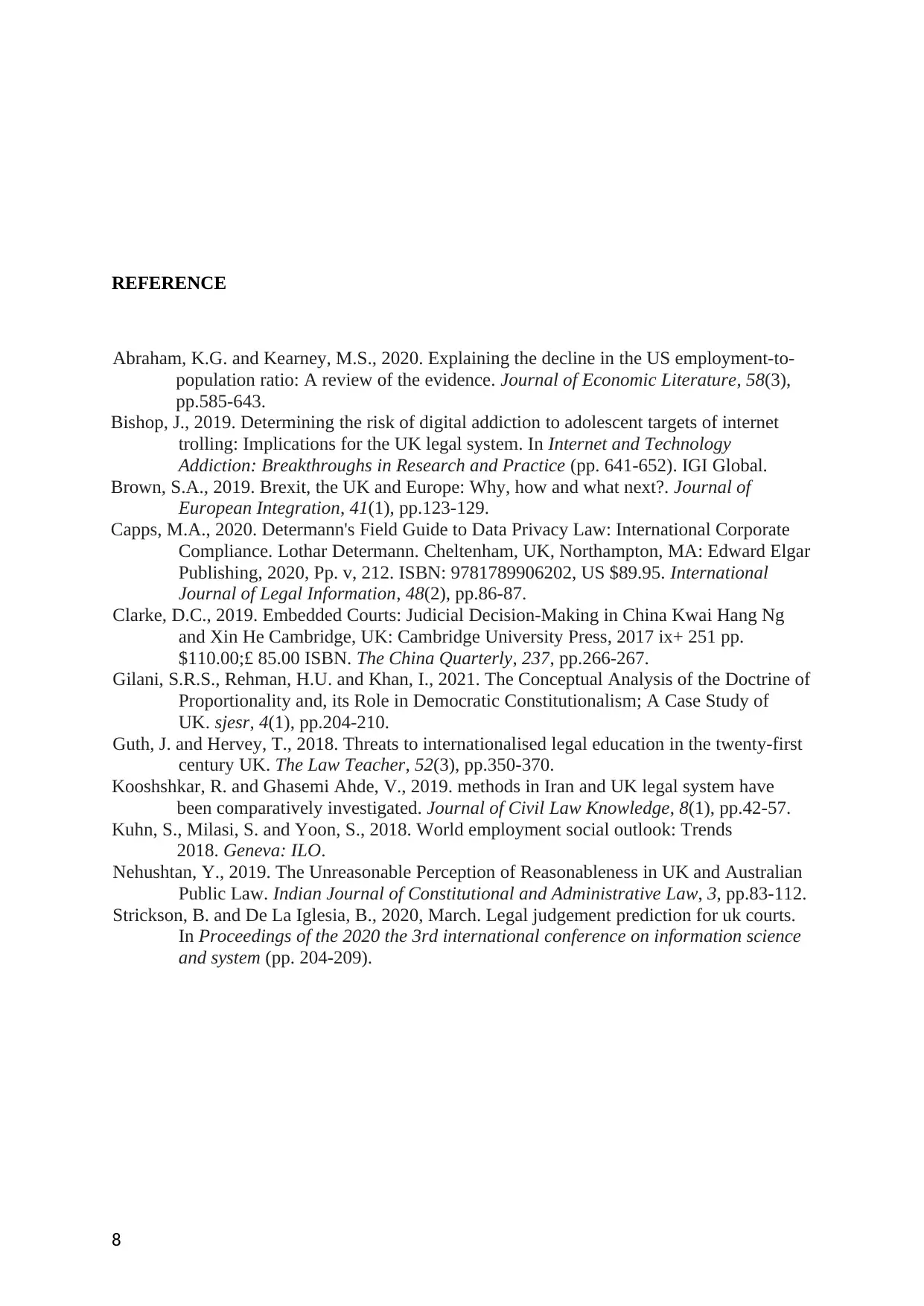
REFERENCE
Abraham, K.G. and Kearney, M.S., 2020. Explaining the decline in the US employment-to-
population ratio: A review of the evidence. Journal of Economic Literature, 58(3),
pp.585-643.
Bishop, J., 2019. Determining the risk of digital addiction to adolescent targets of internet
trolling: Implications for the UK legal system. In Internet and Technology
Addiction: Breakthroughs in Research and Practice (pp. 641-652). IGI Global.
Brown, S.A., 2019. Brexit, the UK and Europe: Why, how and what next?. Journal of
European Integration, 41(1), pp.123-129.
Capps, M.A., 2020. Determann's Field Guide to Data Privacy Law: International Corporate
Compliance. Lothar Determann. Cheltenham, UK, Northampton, MA: Edward Elgar
Publishing, 2020, Pp. v, 212. ISBN: 9781789906202, US $89.95. International
Journal of Legal Information, 48(2), pp.86-87.
Clarke, D.C., 2019. Embedded Courts: Judicial Decision-Making in China Kwai Hang Ng
and Xin He Cambridge, UK: Cambridge University Press, 2017 ix+ 251 pp.
$110.00;£ 85.00 ISBN. The China Quarterly, 237, pp.266-267.
Gilani, S.R.S., Rehman, H.U. and Khan, I., 2021. The Conceptual Analysis of the Doctrine of
Proportionality and, its Role in Democratic Constitutionalism; A Case Study of
UK. sjesr, 4(1), pp.204-210.
Guth, J. and Hervey, T., 2018. Threats to internationalised legal education in the twenty-first
century UK. The Law Teacher, 52(3), pp.350-370.
Kooshshkar, R. and Ghasemi Ahde, V., 2019. methods in Iran and UK legal system have
been comparatively investigated. Journal of Civil Law Knowledge, 8(1), pp.42-57.
Kuhn, S., Milasi, S. and Yoon, S., 2018. World employment social outlook: Trends
2018. Geneva: ILO.
Nehushtan, Y., 2019. The Unreasonable Perception of Reasonableness in UK and Australian
Public Law. Indian Journal of Constitutional and Administrative Law, 3, pp.83-112.
Strickson, B. and De La Iglesia, B., 2020, March. Legal judgement prediction for uk courts.
In Proceedings of the 2020 the 3rd international conference on information science
and system (pp. 204-209).
8
Abraham, K.G. and Kearney, M.S., 2020. Explaining the decline in the US employment-to-
population ratio: A review of the evidence. Journal of Economic Literature, 58(3),
pp.585-643.
Bishop, J., 2019. Determining the risk of digital addiction to adolescent targets of internet
trolling: Implications for the UK legal system. In Internet and Technology
Addiction: Breakthroughs in Research and Practice (pp. 641-652). IGI Global.
Brown, S.A., 2019. Brexit, the UK and Europe: Why, how and what next?. Journal of
European Integration, 41(1), pp.123-129.
Capps, M.A., 2020. Determann's Field Guide to Data Privacy Law: International Corporate
Compliance. Lothar Determann. Cheltenham, UK, Northampton, MA: Edward Elgar
Publishing, 2020, Pp. v, 212. ISBN: 9781789906202, US $89.95. International
Journal of Legal Information, 48(2), pp.86-87.
Clarke, D.C., 2019. Embedded Courts: Judicial Decision-Making in China Kwai Hang Ng
and Xin He Cambridge, UK: Cambridge University Press, 2017 ix+ 251 pp.
$110.00;£ 85.00 ISBN. The China Quarterly, 237, pp.266-267.
Gilani, S.R.S., Rehman, H.U. and Khan, I., 2021. The Conceptual Analysis of the Doctrine of
Proportionality and, its Role in Democratic Constitutionalism; A Case Study of
UK. sjesr, 4(1), pp.204-210.
Guth, J. and Hervey, T., 2018. Threats to internationalised legal education in the twenty-first
century UK. The Law Teacher, 52(3), pp.350-370.
Kooshshkar, R. and Ghasemi Ahde, V., 2019. methods in Iran and UK legal system have
been comparatively investigated. Journal of Civil Law Knowledge, 8(1), pp.42-57.
Kuhn, S., Milasi, S. and Yoon, S., 2018. World employment social outlook: Trends
2018. Geneva: ILO.
Nehushtan, Y., 2019. The Unreasonable Perception of Reasonableness in UK and Australian
Public Law. Indian Journal of Constitutional and Administrative Law, 3, pp.83-112.
Strickson, B. and De La Iglesia, B., 2020, March. Legal judgement prediction for uk courts.
In Proceedings of the 2020 the 3rd international conference on information science
and system (pp. 204-209).
8
1 out of 8
Related Documents
Your All-in-One AI-Powered Toolkit for Academic Success.
+13062052269
info@desklib.com
Available 24*7 on WhatsApp / Email
![[object Object]](/_next/static/media/star-bottom.7253800d.svg)
Unlock your academic potential
© 2024 | Zucol Services PVT LTD | All rights reserved.